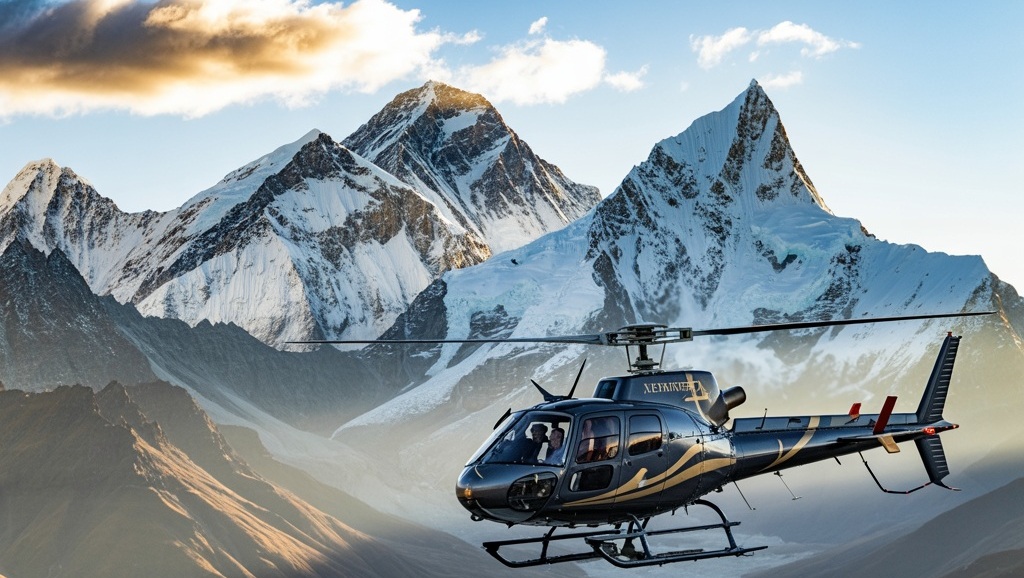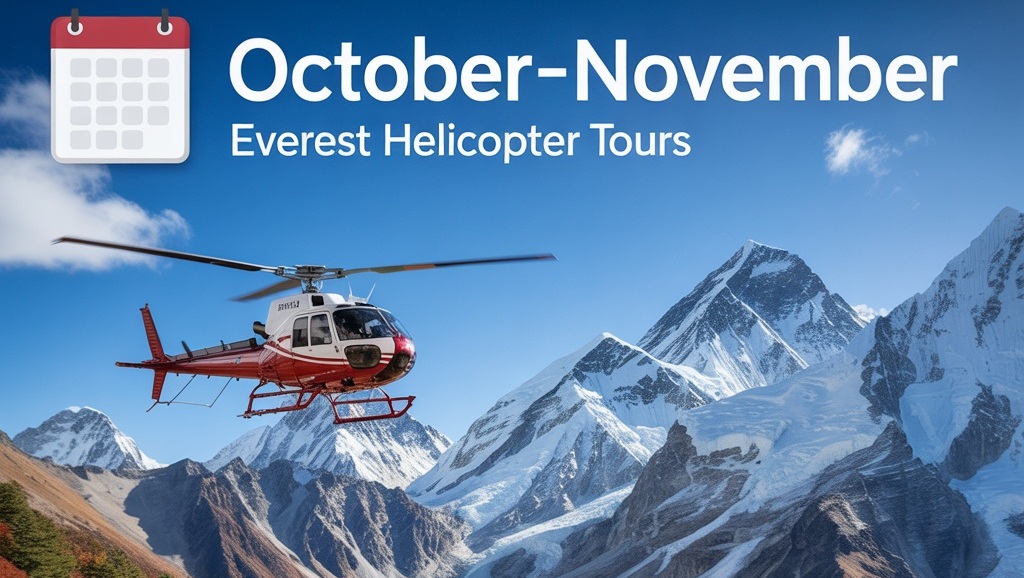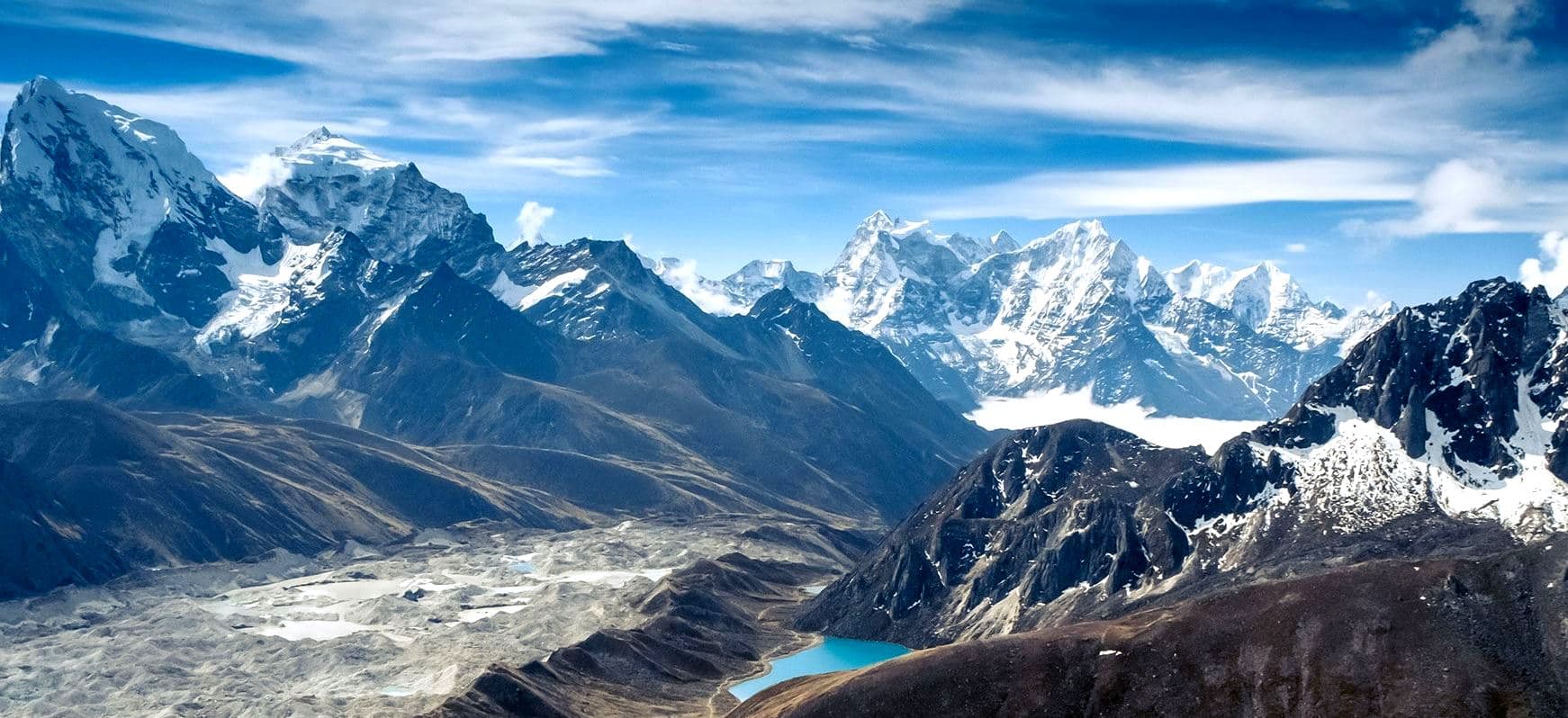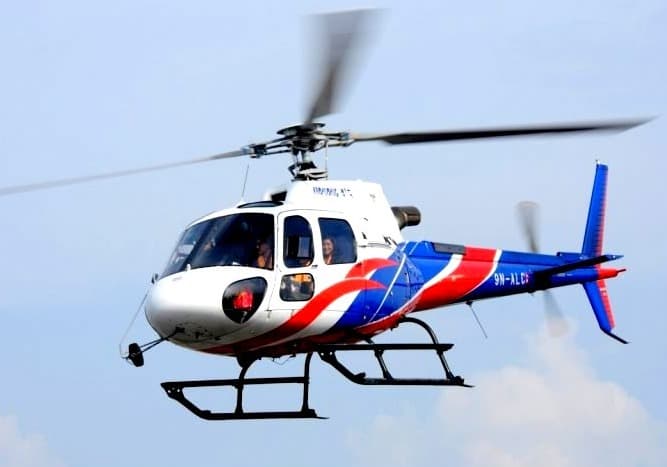Ever imagined seeing Mount Everest not through a muddy trekking trail, but from the open sky? Just hovering beside the world's highest peak while sipping champagne?
For adventure seekers who value both luxury and jaw-dropping views, helicopter tours in the Everest region offer the ultimate shortcut to wilderness wonder. No weeks of hiking required.
These aerial adventures let you witness the Himalayan giants – Everest, Lhotse, Nuptse, and Ama Dablam – in just a few breathtaking hours. The panoramic views of glaciers, remote villages, and snow-capped peaks from your helicopter window rival any National Geographic spread.
But which tour gives you the best bang for your buck? And when should you book to avoid those notorious mountain clouds that can ruin your once-in-a-lifetime photo ops?
The Magic of Everest Helicopter Tours
Breathtaking Aerial Views of the World's Highest Peak
Nothing quite compares to seeing Everest from the air. We've watched countless guests gasp in amazement as they first glimpse the majestic peak through their helicopter window. The panorama unfolds like a living map—massive glaciers, dramatic ice falls, and jagged peaks stretching as far as the eye can see.

From the comfort of your seat, we take you close enough to appreciate the mountain's immense scale while staying at a safe distance. The Khumbu Icefall, Western Cwm, and other famous Everest landmarks appear in perfect clarity, without the days of trekking traditionally required to view them.
Time-Efficient Alternative to Traditional Trekking
Why spend two weeks trekking when you can experience Everest's grandeur in a single day? Our helicopter tours compress what would be a grueling multi-week expedition into an exhilarating few hours.
We've designed these tours for travelers with limited vacation time or those who prefer to avoid the physical demands of high-altitude trekking. You'll still experience the magic of the Everest region—stopping at viewpoints and even the famous Everest View Hotel for breakfast—without sacrificing comfort or time.
Year-Round Accessibility Options
Weather permitting, we operate our helicopter tours throughout the year. Each season offers a unique perspective of the Everest region:
-
Spring (March-May): Rhododendron forests burst with color below while clear mountain views dominate above
-
Summer/Monsoon (June-August): Occasional weather windows between rains reveal lush, green valleys
-
Autumn (September-November): Crystal-clear skies and optimal visibility make this our busiest season
-
Winter (December-February): Snow-covered landscapes create a pristine wonderland with fewer tourists
Luxury Experience with Luxury Holidays Nepal
We don't just fly you to Everest—we create an experience that matches the magnificence of the destination. Our helicopter fleet features modern aircraft with spacious interiors, noise-canceling headsets, and panoramic windows perfect for photography.
Our pilots aren't just skilled aviators; they're knowledgeable guides who point out landmarks and share fascinating insights about the region. We also customize every aspect of your tour—from champagne breakfasts at high-altitude viewpoints to special anniversary or birthday celebrations against the backdrop of the world's highest peak.
Popular Helicopter Tour Packages
Everest Base Camp Helicopter Tour
Nothing beats witnessing the majesty of Everest without breaking a sweat. Our Everest Base Camp helicopter tour is perfect for travelers short on time but big on dreams. We'll fly you from Kathmandu to Lukla, then straight to Kalapatthar (5,545m), offering breathtaking views of Everest Base Camp and surrounding peaks.
The tour typically takes 4-5 hours round trip, including a 10-15 minute stop at Kalapatthar for photos and acclimatization. Imagine capturing Everest, Lhotse, Nuptse, and Ama Dablam from this privileged vantage point!
We schedule most flights early morning when visibility is best and winds are calmest. Each helicopter accommodates 5 passengers, making this a surprisingly affordable way to experience the roof of the world.
Everest Helicopter Tour with Landing
Want more time at the top? Our landing tour includes an extended stop (30-45 minutes) at either Kalapatthar or Everest View Hotel. We'll serve a champagne breakfast with the Himalayas as your dining backdrop - a truly once-in-a-lifetime experience.
This tour gives you ample time to soak in the scenery and take those perfect panoramic shots without feeling rushed. Many of our guests tell us this breakfast was the most memorable meal of their lives!
Extended Helicopter Tours with Multiple Stops
For serious mountain enthusiasts, we've designed multi-stop tours that include Everest Base Camp, Gokyo Lakes, and other stunning locations. These extended flights showcase the diversity of the Khumbu region, from glacial lakes to traditional Sherpa villages.
Our favorite is the "Himalayan Grand Tour" - a 6-hour journey with stops at Lukla, Namche Bazaar, Everest View Hotel, and Kalapatthar. You'll experience different elevations and ecosystems while enjoying comfort breaks at handpicked locations.
Customized Private Tours for Special Occasions
Popping the question? Celebrating an anniversary? We specialize in creating magical moments at the top of the world. Our team has arranged dozens of proposals, birthday celebrations, and even small wedding ceremonies with Everest as witness.
Our private tours offer complete flexibility - you decide where to stop and how long to stay (within safety parameters). We'll handle all details, from photography to champagne service, ensuring your special day becomes an extraordinary memory.
Combination Packages: Trek and Fly Options
Can't decide between trekking and flying? Do both! Our combo packages let you experience the journey and the destination. We recommend trekking up through the beautiful Khumbu Valley, connecting with local culture, then flying back to Kathmandu.
This approach gives you the best of both worlds - the immersive experience of the trek and the spectacular aerial views on return. It's also easier on the knees and saves valuable vacation time.
Our most popular combo is the "Trek Up, Fly Down" - a 10-day adventure that includes a guided trek to EBC followed by a helicopter return to Kathmandu.
What to Expect During Your Helicopter Tour

A. Duration and Itinerary Breakdown
Most of our Everest helicopter tours kick off early morning – typically between 6:00 and 7:00 AM. There's a good reason for this timing: morning flights offer the clearest views before clouds roll in. The entire experience usually spans 4-5 hours, with actual flying time around 90 minutes.
Here's how your day unfolds:
-
30 minutes: Hotel pickup and transfer to Kathmandu airport
-
45-60 minutes: Flight from Kathmandu to Lukla
-
15-20 minutes: Brief stop at Lukla for refueling
-
15 minutes: Spectacular flight to Everest Base Camp or Kala Patthar
-
10-15 minutes: Landing at EBC or Kala Patthar viewpoint
-
5-10 minutes: High-altitude breakfast stop (weather permitting)
-
45-60 minutes: Return journey to Kathmandu
B. Spectacular Photo Opportunities
The photo ops on this tour? Simply mind-blowing. We've strategically designed our flight path to maximize your chances of capturing those jaw-dropping shots.
When we reach Kala Patthar, you'll have about 10-15 minutes (depending on weather and altitude conditions) to snap photos of Everest and surrounding peaks. Our pilots know exactly where to position the helicopter for those perfect angles.
Don't miss these prime photo spots:
-
Sunrise hitting Everest's peak as we approach
-
The dramatic Khumbu Icefall from above
-
The panoramic view from Kala Patthar with Everest, Lhotse, and Nuptse
-
Aerial views of remote Sherpa villages dotting the valleys
-
The lush, dramatic landscape transition from Kathmandu to the Himalayas
C. Safety Briefings and Procedures
Your safety is our absolute priority. Before takeoff, we conduct a comprehensive briefing covering everything you need to know.
Our safety protocol includes:
-
Pre-flight medical check (blood pressure and oxygen levels)
-
Oxygen mask demonstration and usage guidelines
-
Emergency procedures explanation
-
Communication signals with your pilot
-
Guidelines for movement around the helicopter at landing sites
We monitor weather conditions constantly and won't hesitate to modify itineraries if conditions aren't perfect. The high-altitude breakfast stop only happens when oxygen levels and weather permit safe landing.
D. Expert Pilots and Guides
We work exclusively with Nepal's most experienced high-altitude helicopter pilots. Each has logged thousands of flight hours in the Himalayan region and undergoes rigorous ongoing training.
Your pilot isn't just a skilled aviator but a knowledgeable guide who'll point out landmarks and share fascinating insights about the region. Many of our pilots are local to the Everest region and bring personal perspectives about the mountains, culture, and history.
For larger groups, we include a dedicated mountain guide who specializes in Everest ecology, history, and climbing achievements. They'll enhance your experience with stories and facts you won't find in guidebooks.
Best Seasons for Helicopter Tours
Weather Conditions Throughout the Year
The Everest region experiences four distinct seasons, each offering a unique helicopter tour experience. During spring (March-May), we enjoy clear mornings with occasional afternoon clouds. Summer brings the monsoon (June-September), when clouds frequently obscure mountain views. Fall (October-November) rewards us with crystal-clear skies and spectacular visibility. Winter (December-February) offers crisp, clear days but can bring unexpected snowfall and colder temperatures.
Peak Season Benefits (October-November)
October and November are hands-down the best months for our helicopter tours. The skies are at their clearest after the monsoon has washed away dust and pollution. Visibility extends for miles, giving you those jaw-dropping panoramic views of Everest and surrounding peaks. The weather is stable with minimal wind interference, allowing us to operate tours with greater regularity and fewer cancellations. Though it's the busiest time (book at least 3-4 months ahead!), the stunning autumn colors in the lower valleys make for incredible photos.

Off-Season Advantages and Considerations
Spring (March-May) is our second-best season. The mountains are stunning against blooming rhododendron forests, and there are fewer tourists compared to fall. We often offer better rates during this period! Winter flights (December-February) provide the sharpest mountain views on clear days, with the whitest snow-covered landscapes. However, we might need to reschedule flights more often due to unpredictable weather. The big plus? Significantly lower prices and more flexible booking options.
Monsoon Period Limitations
We're straight with our clients - monsoon season (June-September) is challenging for helicopter tours. Cloud cover can be extensive, and views of Everest are often obscured by the time morning progresses. Flights frequently get canceled or rescheduled due to poor visibility and rainfall. However, if you're flexible with dates, we sometimes catch perfect weather windows, especially in early morning hours. The lush green landscapes below are actually at their most vibrant during this season, offering a different kind of beauty that few tourists get to witness.
Practical Information for Travelers
Booking Process with Luxury Holidays Nepal
Booking your Everest helicopter tour with us is simple and stress-free. Start by visiting our website or contacting our team directly. We'll need to know your preferred date, the number of travelers, and any special requirements you might have. Once you've shared these details, we'll check availability and send you a customized itinerary.
To secure your spot, we require a 20% deposit payment. The remaining balance can be paid before your departure date. We accept credit cards, bank transfers, and even PayPal for your convenience. After we receive your deposit, we'll send you a confirmation email with all the important details about your upcoming adventure.
Cost Breakdown and What's Included
Our Everest helicopter tours start from $1,100 per person, though the final price depends on group size and specific itinerary choices. Here's what you get with every package:
-
Helicopter transportation (3-5 hours of flying time)
-
Experienced pilot and safety briefing
-
Landing at Kala Patthar or Everest Base Camp (weather permitting)
-
Breakfast at Everest View Hotel
-
All necessary permits and fees
-
Airport transfers in Kathmandu
-
Professional guide
-
Oxygen cylinders and first aid kit
Not included are personal travel insurance, gratuities, and personal expenses.
Physical Requirements and Health Considerations
While helicopter tours are less physically demanding than trekking, there are still important health factors to consider. The high altitude (up to 5,545m at Kala Patthar) can affect anyone regardless of fitness level.
We recommend:
-
Consulting your doctor before booking if you have heart conditions, respiratory issues, or pregnancy
-
Taking it easy the day before your flight
-
Staying well-hydrated
-
Avoiding alcohol the night before
-
Being honest about your health conditions when booking
We always carry oxygen cylinders and first aid kits on board. Our pilots are trained to recognize altitude sickness symptoms and will descend quickly if needed.
Permits and Documentation Needed
For your Everest helicopter tour, you'll need:
-
A valid passport with at least 6 months validity
-
Nepal tourist visa (available on arrival at Kathmandu airport or online)
-
Two passport-sized photos
-
Travel insurance that covers helicopter evacuation and high-altitude activities
We handle all the specific permits required for flying in the Everest region, including the Sagarmatha National Park entry permit. All these permit fees are included in your tour package.
Recommended Clothing and Equipment
The weather in the Everest region can be unpredictable, and temperatures at high altitudes are significantly colder than in Kathmandu. Pack these essentials:
-
Warm, waterproof jacket
-
Thermal layers
-
Gloves and wool hat
-
Sunglasses (UV protection is crucial at altitude)
-
Sunscreen (SPF 50+)
-
Camera with extra batteries (cold drains batteries faster)
-
Water bottle
-
Light snacks
-
Any personal medications
Even in summer, temperatures at Kala Patthar can drop below freezing, so dressing in layers is your best strategy. Don't worry about carrying heavy equipment—a small backpack with these essentials is all you need for this incredible journey.
Luxury Additions to Enhance Your Experience
Champagne Breakfasts with Himalayan Views
Ever wondered what it feels like to sip champagne while gazing at the highest mountains on Earth? We've crafted this experience just for you. Our helicopter tours come with the option of a champagne breakfast against the backdrop of the majestic Himalayas.
We land at a carefully selected spot where our team quickly sets up a gourmet spread of fresh pastries, fruits, and hot beverages. Pop the cork as the morning sun bathes Everest in golden light. This isn't just breakfast—it's a once-in-a-lifetime memory that combines luxury with nature's grandeur.
Photography Services and Drone Options
Capturing these moments properly is crucial, which is why we offer professional photography services. Our skilled photographers know exactly how to frame the mountains and your reactions to them. They'll document your journey from takeoff to landing, giving you stunning images to share and cherish.
Want something even more special? We can arrange drone photography that captures your helicopter against the vast Himalayan landscape. These aerial perspectives add another dimension to your memories, showing the scale of your adventure in this breathtaking region.
VIP Arrangements and Special Requests
We pride ourselves on saying "yes" to your special requests. Planning a proposal? We'll help coordinate the perfect moment. Celebrating an anniversary? We can arrange customized decorations and keepsakes.
Our VIP service includes private transportation to and from the helipad, priority boarding, and flexible departure times to suit your schedule. We've handled requests ranging from birthday surprises to custom flight routes focusing on specific mountains.
Nothing is too extravagant or too small when it comes to personalizing your Everest helicopter experience. Just ask, and we'll make it happen.
Responsible Tourism in the Everest Region
Environmental Impact of Helicopter Tours
We know that exploring the majestic Everest region is a dream for many, but we're also deeply aware of our responsibility to protect this pristine environment. Helicopter tours, while offering incredible access to remote areas, do have environmental considerations we take seriously.
Noise pollution is perhaps the most immediate impact - our rotors can disturb wildlife and disrupt the peaceful mountain atmosphere that trekkers seek. That's why we carefully plan flight paths to minimize disturbance to wildlife habitats and local communities.
Carbon emissions are another reality we face head-on. A typical helicopter tour produces carbon dioxide that contributes to climate change - something particularly relevant in the Himalayas where glaciers are already retreating at alarming rates.
We're not perfect, but we're committed to improvement. Each flight we operate follows strict guidelines to reduce unnecessary flight time and fuel consumption.
Supporting Local Communities
The Everest region isn't just a spectacular landscape - it's home to Sherpa communities with rich cultural traditions. We make it our mission to ensure tourism benefits these communities directly.
We hire local staff whenever possible - from guides who share authentic stories about their homeland to support personnel who help make your journey memorable. This creates meaningful employment opportunities in remote mountain villages.
A portion of every tour we operate goes directly back to community development projects. We've helped fund schools, health clinics, and infrastructure improvements that benefit locals year-round, not just during tourist seasons.
Sustainable Practices by Luxury Holidays Nepal
We don't just talk about responsibility - we live it. Our commitment to sustainable tourism shapes everything we do in the Everest region. We've implemented a strict "leave no trace" policy for all our tours. This means carrying out all waste, using environmentally friendly products, and ensuring we leave each landing site exactly as we found it. Our fleet includes some of the most fuel-efficient helicopters available for high-altitude operations. We're constantly researching new technologies to reduce our carbon footprint further. Training is another cornerstone of our approach. Every pilot and guide undergoes extensive education about the fragile mountain ecosystem and how to minimize our impact while still delivering unforgettable experiences.
We also offset carbon emissions through partnerships with local reforestation projects. For every tour we operate, trees are planted to help counterbalance the environmental impact.
Soaring over the Majestic Himalayas in a helicopter offers an unparalleled perspective of the Everest region that few get to experience. From the popular tour packages that cater to different preferences and timeframes to the seasonal considerations that ensure optimal viewing conditions, a helicopter tour provides incredible access to this remote wonderland. The journey itself is thoughtfully designed with practical traveler information and luxury additions available to elevate your experience further.
As you contemplate this adventure of a lifetime, remember that responsible tourism practices are essential to preserving the natural beauty and cultural heritage of the Everest region. By choosing Luxury Holidays Nepal for your helicopter tour, you're not only guaranteeing yourself spectacular views of the world's highest peaks but also supporting sustainable tourism initiatives in this fragile ecosystem. Book your helicopter tour today and prepare for an unforgettable aerial journey through one of Earth's most awe-inspiring landscapes.
If you need any further information, please contact us by email: [email protected], Phone: +977- 985 100 5129 (WhatsApp).




